It gathers the greatest mountain peaks in Asia: Tianshan, Karakorum, Himalayas, Tanggula, “Father of Glaciers” Muztag…all of these charming names attract the attention of outdoor people.
Pamir, the most dangerous and mysterious section of the ancient Silk Road.
On this land, there are not only dangerous peaks, lakes, grasslands, Gobi and other changing landscapes like film, but also ancient civilizations that have lasted for thousands of years. They grow together and form a different picture of life. A picture of you and me in a dream. (Note: The pictures not marked in the article are from the photographer Zhao Dengwen).
“
The Pamir Plateau, the largest mountain knot in the world:
-
It is the heaven that divides Central Asia and South Asia;
-
The most difficult and dangerous section of the ancient Silk Road – Congling Ancient Road runs across it;
-
There are many mysterious ancient city ruins;
-
West and East are constantly meeting and colliding here.
Although located in an alpine region, human civilization has never been blocked by the harsh nature, but has become more and more brilliant, harmoniously blending with the unique and beautiful scenery here.

touch the spine of the plateau
Although the Pamir Plateau (called Congling in ancient times) is only a section of the long Silk Road, it is the most important section of it, reflecting the glorious course of more than 2,000 years in the history of human civilization.
-
This is a difficult and dangerous passage where people sleep in the open air, die from hunger and cold, and are shrouded in horse leather;
-
It is also the intersection of Han culture, Indian culture, Arabic culture, Iranian culture and ancient Greek culture;
-
It integrates Buddhism, Manichaeism, Zoroastrianism, Zoroastrianism, Islam and other religions and sects;
-
Indo-European, Altaic, and Sino-Tibetan languages convey the common information of mankind.

Photo/Du Zhuoyi.
When traveling between the mountains and valleys of the East Pamir Plateau, it is no longer the caravans, yaks and camel caravans that carry heavy loads, but the trucks, buses and motorcycles of the mountain people…
Those once glorious fortifications, military platforms and post stations along the Congling Ancient Road are solidified on the plateau together with their long-standing historical mission.
 Hantang Castle Stone Town. “Inscribed in history” and “cultural heritage” are just textbook narratives. When you really step into this ice-clear plateau, a strong shock, obsession and desire for exploration will prompt people to rush to every corner of it, and touch its blood vessels, muscles and bones with their own hands.
Hantang Castle Stone Town. “Inscribed in history” and “cultural heritage” are just textbook narratives. When you really step into this ice-clear plateau, a strong shock, obsession and desire for exploration will prompt people to rush to every corner of it, and touch its blood vessels, muscles and bones with their own hands.
Suddenly travel through time and space
On the east bank of the Taxkorgan River, there is a place called Jirigal. We squeezed into an ancient post station with a narrow door, a round bottom, and a beautiful dome built only with stones and clods. The dome has been blackened by the cow dung fire set by the shepherds, and the kang has been sleeping out of human form by generations of travelers…
Who, for what reason, and by whom, built these ancient inns in this valley where business travelers must pass by by the mountains and rivers?

A suspension bridge in the Taxkorgan valley. They hang precariously over a roaring river that leads to a village, a settlement, or farmland on a flood plain on the opposite bank.
Similar doubts appeared in almost the entire journey of the Taxkorgan Valley. But on this lonely river bank full of Achnatherum splendens, the Jirigal Ancient Post Station and the equally lonely Muztagh Peak in the north of it are far away, silent.
Perhaps, these historical witnesses who have experienced the vicissitudes of the millennium, after completing their great historical achievements that have lasted through the ages, simply disdain to pay attention to these trivial issues.
Golden Grass Beach Ranch in the middle reaches of Taxkurgan River.
On this long passage that crosses the snow-covered plateau, connects multiple countries, bears the footprints of multi-ethnic people, and runs through thousands of years of time and space, countless great achievements are engraved, and countless mysteries are left behind. People are searching hard.

When you are lucky enough to walk on a mountain path in the Pamirs, superimpose the footprints of your hiking shoes on the footprints wrapped in animal skins left by the ancestors; or, drill into a smoky millennium post station and wrap your body in old sheepskins Coat, headrest stones to experience the kind of hardships of business life… I am afraid that no museum in a metropolis can give you the feeling in your heart.
Perhaps, the answers to these questions have not been answered for a while. But history will tell us how many rough roads the ancestors of mankind have gone through before pushing human civilization to the height of today’s society.

Pamir scenery. Think about it, even if it took thousands of years, it would not be easy for the ancestors to build a passage connecting the Asian continent to the Mediterranean here. Its role in history is like a viaduct connecting Eurasian civilization, and it is enough to flaunt its contribution to mankind in the annals of history.
Subash Fields: Views from High
The northern branch of the eastern section of the Congling Ancient Trail is almost entirely located in the West Kunlun Mountains.
It starts from Kashgar, crosses West Kunlun into the eastern Pamir Plateau, and then extends southward along the valley between the east slope of the Sarakuolei Ridge and the west slope of West Kunlun until the east entrance of the Wakhan Corridor.

The Taheman River with nine twists and turns originates from Muztagh Mountain and Sarakuolei Ridge, flows eastward into the Taxkorgan River Valley, and finally becomes a northwestward source of the Yarkant River.
Here, the ancient nature and reincarnated life jointly carve out an irresistible sense of history.
Subash Daban——Subashi Daban towers high in the mountain valley, and can almost be regarded as the best sightseeing platform on the eastern section of the Congling Ancient Road.
It is about 4,500 meters above sea level, almost at the same level as the Muztag Mountaineering Base Camp, and has a very wide field of vision in the east, south and north directions centered on Daban.
The transparent atmospheric environment on the plateau just provides good light conditions for tourists, so that they can easily view the most magnificent plateau landscapes within tens of kilometers around them.
Meet Muztag – the northernmost end of the valley, is the eight or nine graceful silver peaks behind the Gongger Snow Mountain. They are lined up at equal intervals from north to south, like a group of goddesses dancing in the sky. Their elegant dance skirts are integrated with the white and bright top of Gongger Daxue Mountain.
To the south of the Gonger Snow Mountain, the originally complete mountain body extending southward suddenly broke into an irregular mountain range. They are distributed in a mess, forming a transition zone between Konger Mountain and Muztagh Mountain.
Continuing to the south from this transitional zone with a width of more than ten kilometers, the Muztag Mountain with an altitude of more than 7,500 meters rises like an Optimus Prime, becoming the most majestic natural landscape in the southern section of the Congling Ancient Trail. In the six great rift valleys that cut across the mountain, there lie the most magnificent glaciers in West Kunlun, such as Kamatulaga, Kartamark, Kalashong, and Alcheket.

Looking north at Subashi Daban, along the Congling ancient road winding in the valley like a gossamer, which is today’s Subash section of the China-Pakistan Highway, you can see the hidden mountain shadow of Karakul Lake 20 kilometers away. The black and blue water behind, and the sparse small earthen houses in Subash Pastoral Village on the grassy beach of the river valley.
Lake Karakul, which is 3,600 meters above sea level, together with Muztagh Peak, which is 7,546 meters above sea level, constitute the most magnificent plateau landscape on the East Pamirs.
There are two heavens on the plateau—upper and lower Daban, with very different climates. Lake Karakuli is 3,600 meters above sea level, and it is only 3,700 meters southward to Ululawat Daoban on the north side of Subashi Daban. During the more than 20 kilometers, bathed in the warm sunshine in the river valley, the eyes are full of grass-colored land, rocky rivers, low herdsmen’s huts and yak calves playing in the wilderness.
Starting from Ulu Rawat and gradually climbing to the top of Daban along the long winding mountain road, the herdsmen’s huts, cow dung cake piles and jumping yak calves gradually melted into the vast land.

Occasionally, a few bright spots of light appear on the plain ground, which must be the busy Tajik women walking out of their pasture houses.
At the top of Daban, the cold mountain wind blows, carrying a few cold snowflakes on a sunny day. After a while, the soft warmth in the valley was completely lost, replaced by the cold air that swam through the clothes like a snake, and a feeling of suffocation accompanied by a slight dizziness hit people.
Just when people were elated to easily ascend the Daban at an altitude of more than 4,000 meters, the natural force silently reminded you in its most humorous way.
Wakhan Corridor: Highland Cultural Road
The Wakhan Corridor has a total length of 400 kilometers, starting from Dabudar Township in Taxkorgan Tajik Autonomous County, China at the east end, and ending at the eastern border of Badakhshan Province, Afghanistan at the west end.
The Chinese section of the entire corridor is from Paiyike to Kekturuk, with a total length of about 90 kilometers. It borders Pakistan, Tajikistan, and Afghanistan in the south, north, and west directions, which can be called border crossings.

The landscape of Gezi River Valley and Konger Mountain at the turn of winter and spring.
The entrance at the eastern end of the Wakhan Corridor is narrow, but it suddenly feels open after entering, like a retort with a narrow throat and a wide interior. There is a sidewalk that cuts directly into the deep part of the corridor from the Mazha Sheep Farm.
The further west you travel along the Wakhan Corridor, the higher the altitude. What flows in the corridor is no longer the Karachikur River going east, but the Panchi River going west.
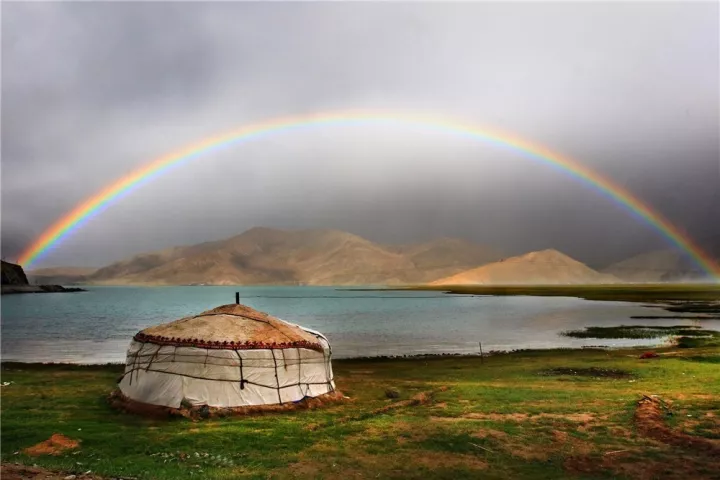
Encounter a rainbow in the sky.
In August, the autumn grass has begun to fall. To the west of Wakhan First Post, there is a horseshoe-shaped plateau pasture in the Pamirwan Mountains.
Men in their prime move to the Taxkorgan River Valley in the east to harvest hay and fodder one after another. The elderly, women and children are the protagonists of this plateau pasture. Before dusk, they walked out of the door to greet us with kind, shy, and simple smiles.
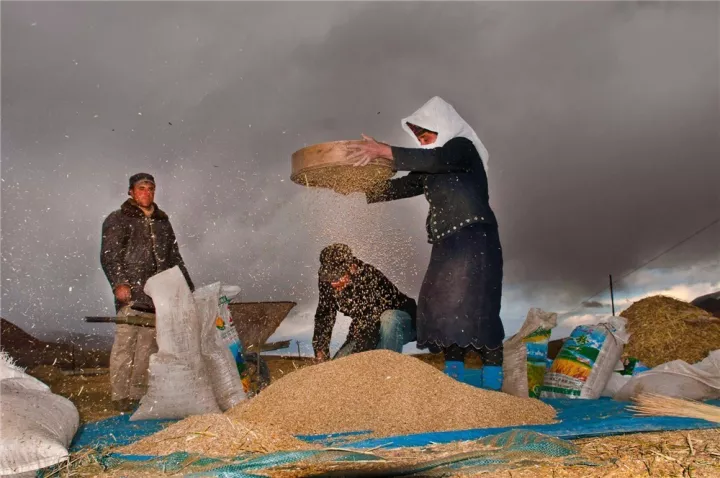
A Tajik family is harvesting highland barley. The Tajik people mainly live on animal husbandry, and in the river valleys where conditions permit, they also engage in planting.
The altitude here is more than 4700 meters. Panting heavily, we shuttled across the pasture, teasing children with body language, chatting with women and the elderly with hand gestures, dodging the chasing of the shepherd dogs with the remaining physical strength, and following the few herds.
That afternoon, thick overcast clouds had been lingering over the Hindu Kush mountain tops, which was not conducive to photography. But since the plateau people originally lived in this kind of confusing weather, we would rather freeze this authenticity in order to give it a true interpretation.
A typical festival ceremony at the Gongbahar Festival – eating Baijia Naan. The Xiaogong Bahar Festival is the most important agricultural festival for the Tajik people. The season is equivalent to the vernal equinox. It is composed of a series of small festivals such as the Water Diversion Festival and the Sowing Festival. It is intended to celebrate the beginning of the year.
Horseback Nation: Gentleman’s Feelings
The vigor and beauty of the Pamirs are also rooted in the blood of the people of all ages.
Different from the charming and handsome water towns in the south of the Yangtze River, this Pamir Plateau with an average altitude of more than 4000 meters, because of its continuous mountains, towering silver peaks, crisscross rice fields, winding glaciers, roaring mountain streams and deep river valleys The structure, its natural temperament is hard lines.
Similarly, the vigorous and beautiful qualities of the Pamirs are also firmly rooted in the flesh and blood of its eternal people who live with it.
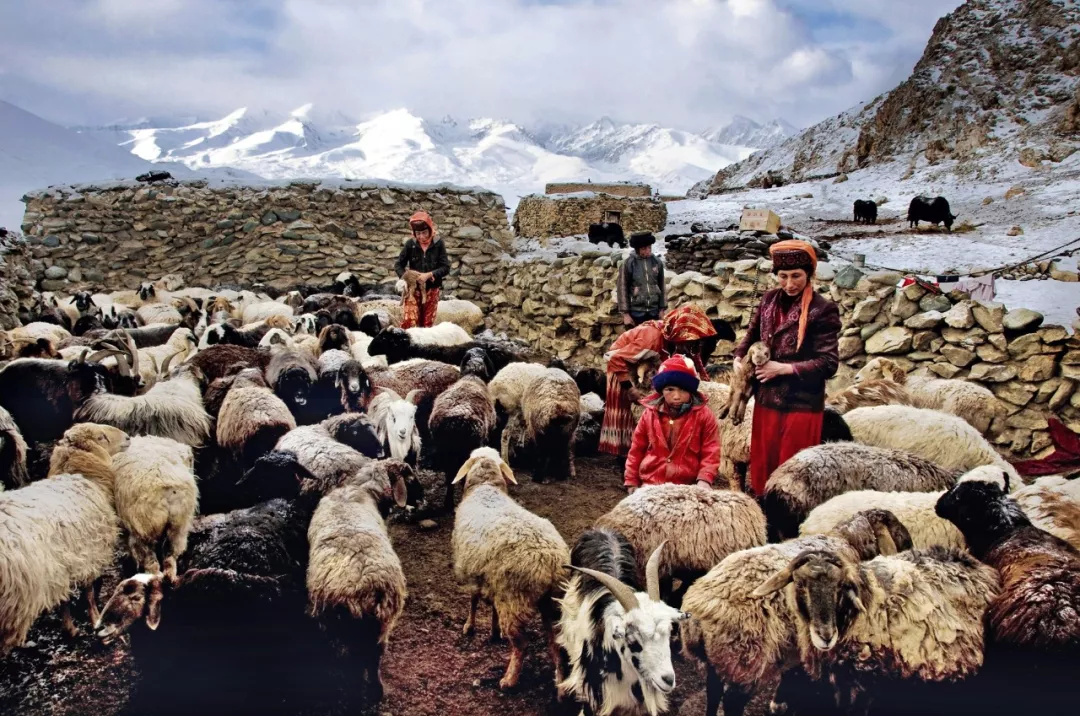
Difficult sheep competition, sudden danger——In late autumn, in Tizinapu Township, Taxkorgan, a fierce sheep competition is underway. Dozens of fierce Tajik riders galloped on their horses, sweating profusely.
In the fierce competition, suddenly, a rider lost his body and fell off his horse, and fell into the rumbling and dusty horseshoes. His excited horse, because it suddenly lost the master’s control, rushed and ran wildly aimlessly.
If you have personally experienced the scene of thousands of horses galloping across the land, and the power of the forest of horse legs made of strong muscles, strong bones, heavy panting and shining horseshoes, you can’t help but be amazed by that. Worrying about the fate of the famous rider.
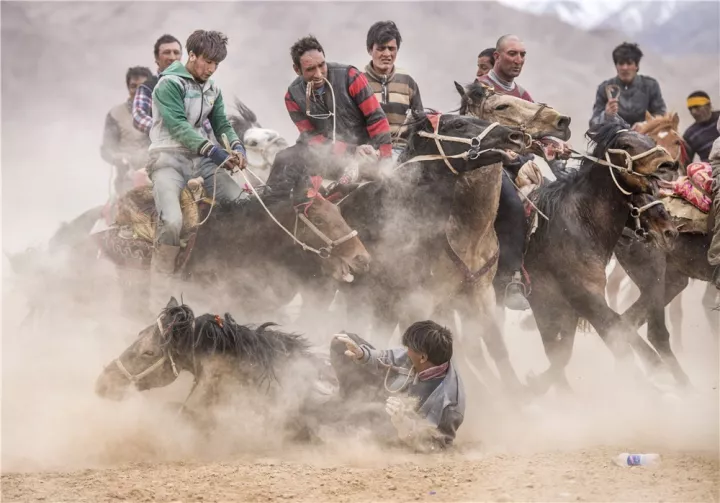
I abandoned the scene of fierce competition at the front of the horse team, and turned to pay attention to the fate of the fallen rider through my binoculars. But what I saw was such a moving scene.
However, at the moment when the rider fell off the horse, several riders participating in the competition—are they allies or opponents—quickly gathered the reins of the horse with agility and left the race. Desperately carve out a narrow safety zone to protect the fallen rider.
There are also riders who temporarily put down the race, pull the fallen horse onto his own horse’s back, and ride the horse to recover the mount that lost its owner, so that its owner can jump on the horse’s back again and show off. In just over ten seconds, these Tajik men re-entered the swiftly rolling cloud of dust to continue their struggle, twisting and killing.
The sports competitions of the horseback people not only show their bravery, ferocity and strength, but also show their bravery and gentlemanliness.
The yak is the most important production tool of this plateau nation, and it is also a symbol of the tenacity and strength of Tajik men. Like horse racing, yak holding sheep is one of the Tajik people’s favorite recreational sports.
Live in harmony with nature—however, the blindly hard lines are not the deliberate pursuit of the Tajiks, it is just the necessary potential for them to adapt to the environment and resist the forces of nature.
Like any nation, they yearn for peace and beauty, and follow the irresistible laws of nature throughout the year.
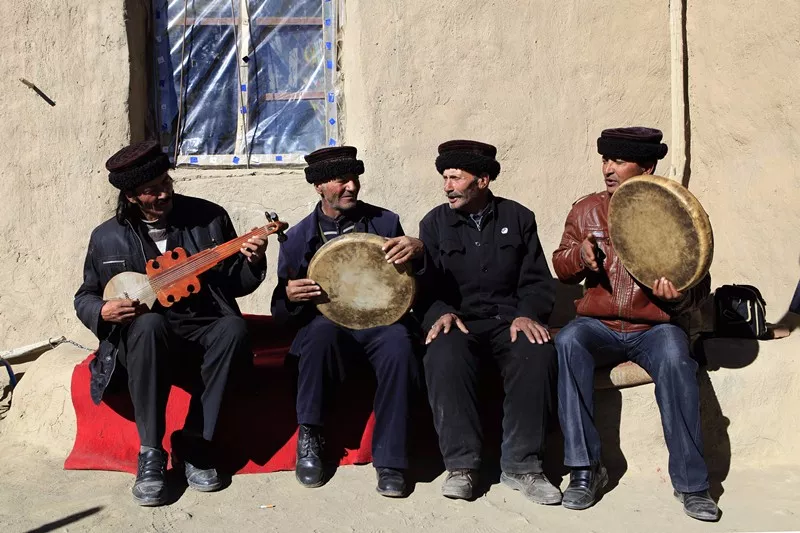
Eid al-Adha, Rozi, Shogun Bahar, Pirik, Zuur, Iron and Muzuwas… These traditional festivals closely related to labor and life deeply reflect the It means that the Tajik people’s philosophical concepts about nature, society and interpersonal relationship have become a very distinctive external expression of their spiritual world since ancient times.
Women of the horseback nation—in my opinion, one of the best windows of this kind of spiritual world is the other half of the Tajik people, Tajik women, especially their eyes.
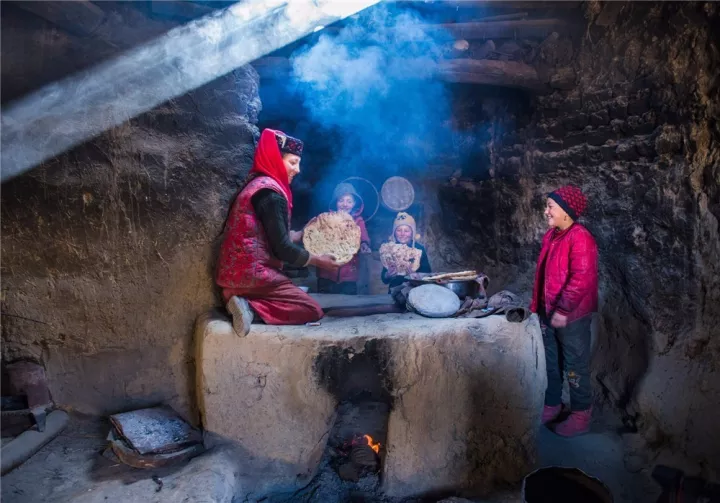
A Tajik girl making naan on the naan pit. No matter at home or in nomadic life, naans of various shapes are the daily staple food of Tajik people.
On this plateau with harsh natural conditions, they share the hard work with men all year round, but they can’t get rid of the noble temperament that penetrates into the blood vessels and implants in the bone marrow. That kind of friendliness, kindness and warmth has painted this land with a touch of rose red.
life in the plateau
With an eagle flute, a tambourine, a small courtyard, and two or three neighbors, they played a plateau pastoral song.
Maimat Shabrajiang, he lives in Quman Village at the northern end of Tiznafu Township. Compared with the rugged mountains of the Pamirs, this is a geomantic gem. Figure / Zhang Yaodong
Seeing us coming, the wife of Tajik folk artist Maimaiti Shabrajan with beautiful gray-blue eyes hurriedly disappeared behind the willow bushes.
After a while, Shabrajiang appeared in front of us, with a hearty smile flowing from the ditch-like wrinkles on his face.
As usual, it is a blue Gaili style building with many colonnades, but Shabrajiang’s residence is quite old. Langaili-style houses with corridors, skylights and wooden columns are the traditional architectural form of the Tajiks; kang blankets and tapestries are the favorite interior decorations of the Tajiks.
A few sacks of grain were piled up at the door, and two chairs that obviously did not belong to the original Tajik furniture were placed against the edge of the Kang, and they wobbled on them. Hooks made of twigs hang from beams, pillars, and walls, on which wicker baskets and the like are hooked. Small embroideries are inlaid in the frame, adding a smoky and dusty feel.
Shabrajiang’s home outlines the simple and simple life style unique to plateau herdsmen – at least that’s my first impression.
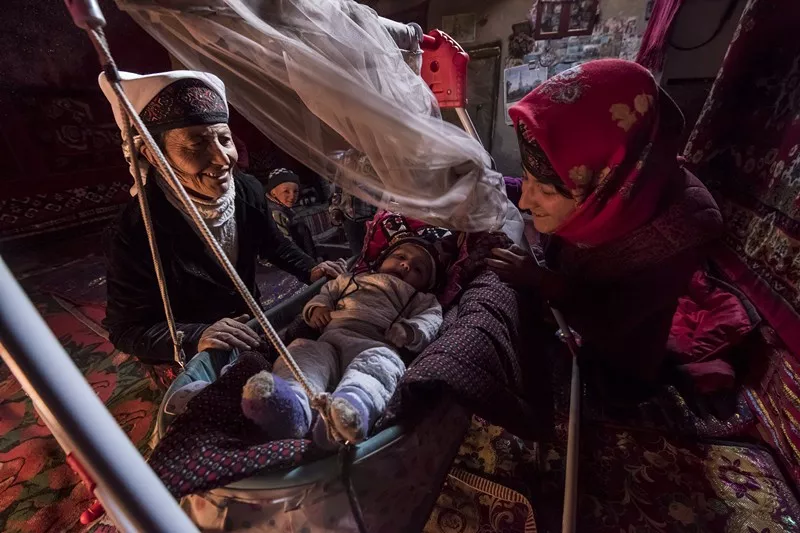
The object that can lead to the personal characteristics of Shabrajiang as a folk artist is the Tajik tambourine that is placed on the pile of quilts in the corner of the Kang and is larger than usual. On the drum surface of this tambourine, a head portrait of Shabrajiang playing the eagle flute is vividly painted.
The impromptu performance took place on the yard behind the house, and several good-bred native chickens and a cat basking in the sun were driven away from the venue.
This time, the handsome man Shabrajiang wore an old white sheepskin coat, a ball of stuffing imitating a hunchback, a lambskin hat with a white top and black brim, and two strands of cotton for a mustache.
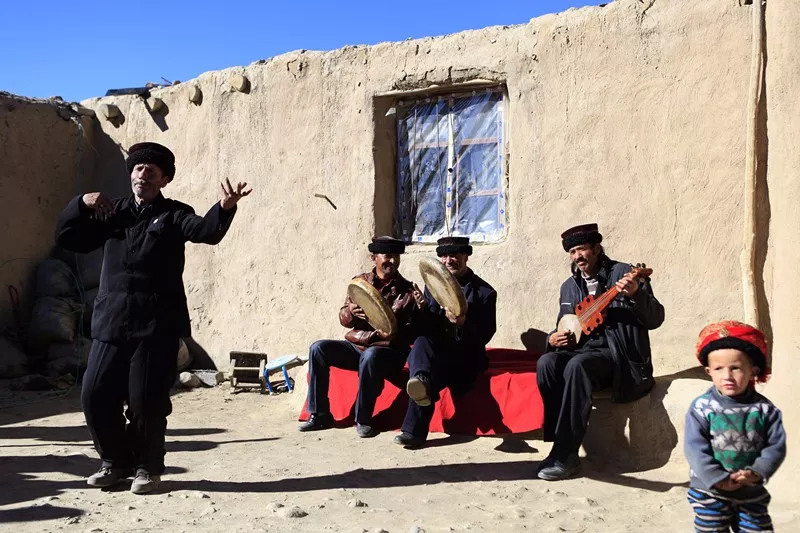
There is no program description, and the cumbersome reporting process is omitted. When we were waiting in the yard, Shabrajiang, with a funny smile on his face, suddenly jumped onto the stage from the door of the house with a hunchback and bent legs. , the vividness of the face does not seem to be under Chaplin.
On this small piece of ground that looks flat but is actually uneven, Shabrajiang, wrapped in an old sheepskin coat, kicked his skillful dance steps like a young man, with the expression of an old urchin, to know his destiny. There are still words in the mouth. After a while, the old urchin’s wife jumped onto the stage, kicking her beautiful legs in black boots.
At this time, the old urchin transformed into a hard-jointed puppet action that made people laugh, sticking out his tall eagle nose, shrugging his broad shoulders, shaking his flexible hips, spinning, chasing and teasing. What remains the same is those two gazes locking each other like hooks.
Finally, amidst the heart-warming laughter of the crowd, Shabrajiang’s two fake beards flew into the sky and landed in a spin, but he himself instantly solidified into a statue of cast copper and iron looking up at the sky, attracting a crowd of people. The buzzing sound of the shutter.
Such a program only needs an eagle flute, a tambourine, a small courtyard, and two or three randomly invited neighbors from Quman Village as musicians to start the performance.
The local and popular character in it may be beyond the reach of any king or empress in the entertainment industry today.

As long as time is passing and life continues, the notes of life will jump happily in various rhythms.
I also have no intention to show that the plateau life sonata is just playing its idyllic side blindly. The joys and sorrows of life always exist side by side with the long river of life.




